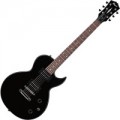Volume controls
The number of volume controls provided in an electric guitar.
If there is only one knob, this means that the musician can only adjust the overall volume of the instrument. However, there are models that have several volume control knobs — usually there are no less of them than pickups (2 or 3), which allows you to separately adjust the volume of each pickup. And since the characteristics of the sound depend on the type of the used pickup (see "Pickup Diagram") and even its location, then by changing the mutual volume of the individual pickups, you can achieve different coloring of the sound. At the same time, the design may also include a general volume control, which allows you to adjust it in the classical way and not mess with the settings of each pickup.
Tone controls
The number of tone controls provided in the design of an electric guitar.
One tone control is responsible for the sound of the electric guitar as a whole; but if there are several such pens, they can have different formats of work. So, each knob can be responsible either for its own pickup, or for a separate frequency band. In the second case, a set of knobs plays the role of an equalizer that allows you to adjust the sound by changing the volume of low and high (sometimes even separately middle) frequencies.
Anyway, the presence of several tone controls expands the possibilities for changing the coloring of the sound by means of the guitar itself, without the use of additional equipment.
Material
The material from which the body of an electric guitar is made. For models with cutouts (semi-acoustic, see "Type"), in this case, only the material of the back deck and sides can be taken into account, and data on the top deck is given separately (for more details, see "Deck Cover Material").
Now on the market there are cases of such trees:
red,
maple,
agatis,
ash,
alder.
It makes no sense to dwell on each of the materials found in modern electric guitars. Their variety is very large, however, unlike acoustic guitars, the body in this case does not play such a significant role in shaping the sound, and its material has a relatively small effect on the acoustic properties of the instrument (although the exact degree of such influence is a moot point). If you wish, you can find detailed data on a particular material in special sources, but in fact it makes sense to look primarily at the appearance of the instrument and its price category.
Body top
The material from which the soundboard cover is made is an additional overlay on the upper soundboard, which primarily plays a decorative role and gives the instrument a pleasant appearance. Do not confuse such a cover with a protective overlay (see above about it). And in semi-acoustic instruments with a hollow body (see "Type"), this paragraph may indicate the material of the upper soundboard, and a separate cover as such may be absent.
In general, the value of this parameter is similar to the material of the body (see above) — adjusted for the fact that the deck cover also directly determines the appearance of the electric guitar, and in semi-acoustic models it affects the sound more than the rest of the body. However, the main criterion for choosing this parameter may well be the aesthetic preferences of the musician.
Fretboard radius
The radius of curvature of a fretboard mounted on the fretboard of an electric guitar.
The fingerboard is located directly under the strings, it is to it that the musician presses the strings when playing. If you look at the neck in cross section, its upper part with the overlay will have the shape of an arc; the radius of this arc is implied in this case. The smaller the radius, the more convex this arc will be, and vice versa, a large radius will correspond to an almost flat surface.
In general, it is believed that a smaller fingerboard radius is better for playing chords, and a more even, flat surface makes it easier to play technical passages with an abundance of special techniques such as bands. The average and, one might say, classic diameter value is 12", this is the most popular option among modern electric guitars. The smallest figure is just over 7", it is found in some guitars with Stratocaster bodies (both original Fender instruments and copies ). And the most flat pads have a diameter of 20" or more.
Note that there are often instruments with a variable fretboard radius — smaller at the headstock (where chords are played more often) and larger near the body (where solos are played by notes). In such cases, the radius at the nut is indicated.

